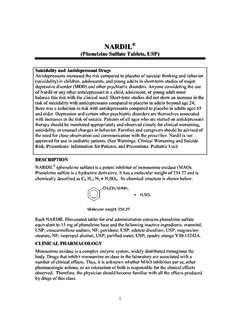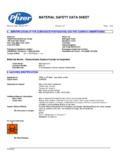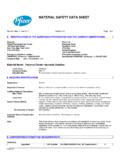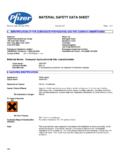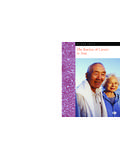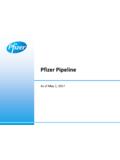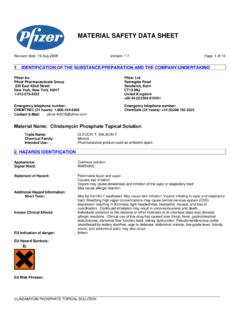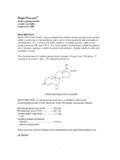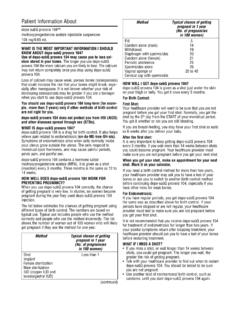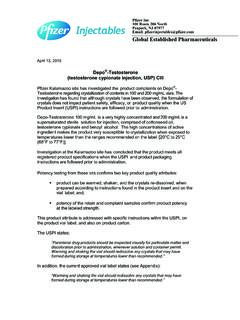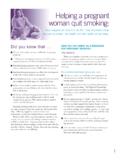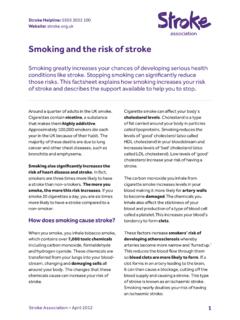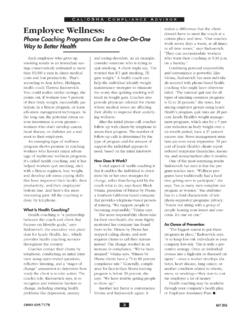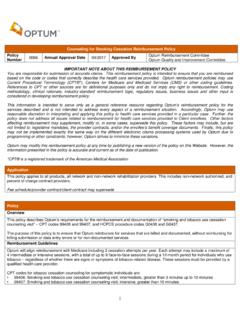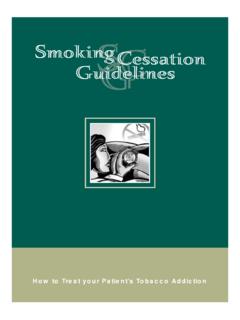Transcription of Nicotrol NS DESCRIPTION - Pfizer
1 Nicotrol NS(nicotine nasal spray)10 mg/mLDESCRIPTIONN icotrol NS (nicotine nasal spray) is an aqueous solution of nicotine intended for administration as a metered spray to the nasal is a tertiary amine composed of pyridine and a pyrrolidine ring. It is a colorless to pale yellow, freely water-soluble, strongly alkaline, oily, volatile, hygroscopic liquid obtained from the tobacco plant. Nicotine has a characteristic pungent odor and turns brown on exposure to air or light. Of its two stereoisomers, S(-)nicotine is the more active. It is the prevalent form in tobacco, and is the form in Nicotrol NS. The free alkaloid is absorbed rapidly through skin, mucous membranes, and the respiratory Name: S-3-(1-methyl-2-pyrrolidinyl) pyridineMolecular Formula: C10H14N2 Molecular Weight: Constants: pKa1 = , pKa2 = at 15 COctanol-Water Partition Coefficient: 15:1 at pH 7 Each 10 mL spray bottle contains 100 mg nicotine (10 mg/mL) in an inactive vehicle containing disodium phosphate, sodium dihydrogen phosphate, citric acid, methylparaben, propylparaben, edetate disodium, sodium chloride, polysorbate 80, aroma and water.
2 The solution is isotonic with a pH of 7. It contains no priming the delivery system for Nicotrol NS, each actuation of the unit delivers a metered dose spray containing approximately mg of nicotine. The size of the droplets produced by the unit is in excess of 8 microns. One Nicotrol NS unit delivers approximately 200 PHARMACOLOGYP harmacologic ActionNicotine, the chief alkaloid in tobacco products, binds stereo-selectively to nicotinic-cholinergic receptors at the autonomic ganglia, in the adrenal medulla, at neuromuscular junctions, and in the brain. Two types of central nervous system effects are believed to be the basis of nicotine s positively reinforcing properties. A stimulating effect is exerted mainly in the cortex via the locus ceruleus and a reward effect is exerted in the limbic system.
3 At low doses, the stimulant effects predominate while at high doses the reward effects predominate. Intermittent intravenous administration of nicotine activates neurohormonal pathways, releasing acetylcholine, norepinephrine, dopamine, serotonin, vasopressin, beta-endorphin, growth hormone, and cardiovascular effects of nicotine include peripheral vasoconstriction, tachycardia, and elevated blood pressure. Acute and chronic tolerance to nicotine develops from smoking tobacco or ingesting nicotine preparations. Acute tolerance (a reduction in response for a given dose) develops rapidly (less than 1 hour), but not at the same rate for different physiologic effects (skin temperature, heart rate, subjective effects). Withdrawal symptoms such as cigarette craving can be reduced in most individuals by plasma nicotine levels lower than those from from nicotine in addicted individuals can be characterized by craving, nervousness, restlessness, irritability, mood lability, anxiety, drowsiness, sleep disturbances, impaired concentration, increased appetite, minor somatic complaints (headache, myalgia, constipation, fatigue), and weight gain.
4 Nicotine toxicity is characterized by nausea, abdominal pain, vomiting, diarrhea, diaphoresis, flushing, dizziness, disturbed hearing and vision, confusion, weakness, palpitations, altered respiration and smoking and nicotine can increase circulating cortisol and catecholamines, and tolerance does not develop to the catecholamine-releasing effects of nicotine. Changes in the response to a concomitantly administered adrenergic agonist or antagonist should be watched for when nicotine intake is altered during Nicotrol NS therapy and/or smoking cessation (See PRECAUTIONS, Drug Interactions).PHARMACOKINETICSEach actuation of Nicotrol NS delivers a metered 50 microliter spray containing approximately mg of nicotine. One dose is considered 1 mg of nicotine (2 sprays, one in each nostril).
5 AbsorptionFollowing administration of 2 sprays of Nicotrol NS approximately 53% 16%(Mean SD) enters the systemic circulation. No significant difference in rate or extent of absorption could be seen due to the deposition of nicotine on different parts of the nasal mucosa. Plasma concentrations of nicotine obtained from 1 dose (1 mg nicotine) of Nicotrol NS rise rapidly, reaching maximum venous concentrations of 2 12 ng/mL in 4 15 minutes. The apparent absorption half-life of nicotine is approximately 3 minutes. There is wide variation among subjects in their plasma nicotine concentrations from the spray. As a result, after a 1 mg dose of spray approximately 20% of the subjects reached peak nicotine concentrations similar to those seen after smoking one cigarette (7 17 ng/mL) (See DRUG ABUSE AND DEPENDENCE Section).
6 Figure 1 below plots the mean and 5th and 95th percentile nicotine concentrations after a 1 mg single dose of the nasal spray (n=30).Table 1: Trough Plasma Nicotine Concentrations after 11 Hours of DosingWith 1 mg, 2 mg and 3 mg of Nicotrol NS per hour (n=16).DoseMean (ng/mL) SD (Range)1 mg every 60minutes (1 mg/hr)6 3( 12)1 mg every 30minutes (2 mg/hr)14 6( 24)1 mg every 20minutes (3 mg/hr)18 10( 35)The data from Table 1 is derived from a three-way cross-over study of repeated applications of Nicotrol NS in sixteen smokers (8 male, 8 female) ranging in age from 18 to 48 years. There is a slight deviation from dose-concentration proportionality from one dose to three doses of Nicotrol NS per hour as shown in Figure smokers (7 males and 9 females) ranging in age from 22 to 44 years were dosed with 1 mg of Nicotrol NS every hour for 10 hours.
7 The pharmacokinetic parameters that were obtained are presented in Table 2: Nicotine Pharmacokinetic Parameters at Steady-State for 1 mg/hour of Nicotrol NS AdministeredHourly for Ten Hours (Mean SD and Range), (n=16).Parameter 1 mg (2 sprays)(Range)Cavg (ng/mL)8 3( )Cmax (ng/mL)9 3( )Tmax (minutes)13 5(10-20)Cavg: average plasma nicotine concentration for the dosing interval of 10-11 hoursCmax: maximum measured plasma concentration after last dose administrationTmax: time of maximum plasma concentration after last dose administrationDistributionThe volume of distribution following IV administration of nicotine is approximately 2 to 3 L/kg. Plasma protein binding of nicotine is <5%. Therefore, changes in nicotine binding from use of concomitant drugs or alterations of plasma proteins by disease states would not be expected to have significant effects on nicotine than 20 metabolites of nicotine have been identified, all of which are less active than the parent compound.
8 The primary urinary metabolites are cotinine (15% of the dose) and trans-3-hydroxycotinine (45% of the dose). Cotinine has a half-life of 15 to 20 hours and concentrations that exceed nicotine by 10-fold. The major site for the metabolism of nicotine is the liver. The kidney and lung are also sites of nicotine 10% of the nicotine absorbed is excreted unchanged in the urine. This may be increased to up to 30% with high urine flow rates and urinary acidification below pH 5. The average plasma clearance is about L/min in a healthy adult smoker. The apparent elimination half-life of nicotine from Nicotrol NS is 1 to 2 ModelThe data were well described by a two-compartment model with first-order on individual fits (N=18) the following parameters were derived after the administration of a 1 mg dose: Absorption rate constant (Ka) = hr-1 (Mean SD), Elimination rate constant (Ke) = hr-1, Distribution rate constants(K12) = hr-1, (K21) = hr-1, Volume of distribution over fraction absorbed (V/F) = L/kg in 8 female and 10 male adults weighing 76 15 DifferencesIntersubject variability (50% coefficient of variation) among the pharmacokinetic parameters (AUC, Cmax and Clearance/kg) were observed for both genders.
9 There were no differences between females or males in the kinetics of Nicotrol InteractionsThe extent of absorption is slightly reduced (approximately 10%) in patients with the common cold/rhinitis. In patients with rhinitis the peak plasma concentration is reduced by approximately 20% (concentrations are lower by ng/mL on average) and the time to peak concentration prolonged by approximately 30% (delayed by 7 minutes on average). The use of a nasal vasoconstrictor such as xylometazoline in patients with rhinitis will further prolong the time to peak by approximately 40% (delayed by 15 minutes on average), but the peak plasma concentration remains on average the same as those with TRIALSThe efficacy of Nicotrol NS therapy as an aid to smoking cessation was demonstrated in three single-center, placebo-controlled, double-blind trials with a total of 730 patients.
10 One of the trials used Nicotrol NS with individual counseling while the other two used group support. Patients with severe or symptomatic cardiovascular disease, hypertension, asthma, diabetes or severe allergy were not included in the studies. The amount of Nicotrol NS used was left to the discretion of each patient, with a minimum dose of 8 mg/day and a maximum dose of 40 all three studies, the recommended duration of treatment was 3 months; however in two of these trials, 241 patients were permitted to continue to use the product for up to 1 year, if they wished. Among the 64 patients abstinent from cigarettes at the end of a year, 23 (36%) were still using the spray, and probable dependence on the spray was seen in several patients (See DRUG ABUSE AND DEPENDENCE).
